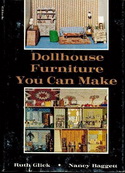Dollhouses
 Ruth got into designing dollhouse furniture when her daughter, Elissa, was a preschooler. She wanted a dollhouse, and a family friend volunteered to build it. Decorating and outfitting the house was an outlet for Ruth’s creativity, and she began designing miniature furniture, using various clever techniques. Many of her furnishings were made from common objects–like a modern headboard fashioned from the bottom of a cassette tape box, with a strip of balsa wood painted black for an interior shelf. Or ice cream parlor chairs made from champagne cork wires. She also developed a technique for making “antique”cabinet pieces from heavy cardboard decorated with flat lace strips and then painted.
Ruth got into designing dollhouse furniture when her daughter, Elissa, was a preschooler. She wanted a dollhouse, and a family friend volunteered to build it. Decorating and outfitting the house was an outlet for Ruth’s creativity, and she began designing miniature furniture, using various clever techniques. Many of her furnishings were made from common objects–like a modern headboard fashioned from the bottom of a cassette tape box, with a strip of balsa wood painted black for an interior shelf. Or ice cream parlor chairs made from champagne cork wires. She also developed a technique for making “antique”cabinet pieces from heavy cardboard decorated with flat lace strips and then painted.
 At the time, she and Nancy Baggett had been writing magazine articles together, and they decided to see if they could sell a book on making dollhouse furniture. Their proposal sold to A. S. Barnes,and they began working on DOLLHOUSE FURNITURE YOU CAN MAKE, (ISBN: 0498019942, A. S. Barnes, 1977), with Nancy’s husband, Charlie Baggett, photographing the pieces for them. That was before the invention of word processors, and typing and proofreading the manuscript was a time-consuming process, since it was full of measurements for fabric and cardboard construction materials.
At the time, she and Nancy Baggett had been writing magazine articles together, and they decided to see if they could sell a book on making dollhouse furniture. Their proposal sold to A. S. Barnes,and they began working on DOLLHOUSE FURNITURE YOU CAN MAKE, (ISBN: 0498019942, A. S. Barnes, 1977), with Nancy’s husband, Charlie Baggett, photographing the pieces for them. That was before the invention of word processors, and typing and proofreading the manuscript was a time-consuming process, since it was full of measurements for fabric and cardboard construction materials.
The team went on to sell DOLLHOUSE LAMPS AND CHANDELIERS (ISBN: 0875881491, Hobby House Press, 1979). After Nancy moved with her husband to Germany for a four-year tour of duty, Ruth wrote DOLLHOUSE KITCHEN AND DINING ROOM ACCESSORIES (ISBN: 0875881505, Hobby House Press, 1979) by herself.

